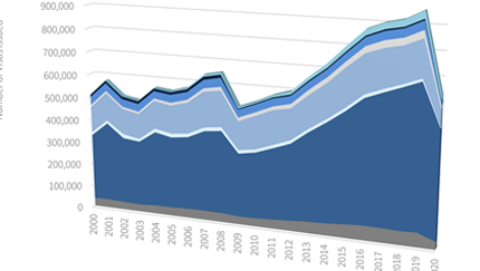Business and the Workforce

Immigrant Workers in the U.S. Labor Force
The Brookings Institution and New American Economy published “Immigrant Workers in the U.S. Labor Force,” a study analyzing the differences in both the occupations and education levels of immigrant and native-born workers in the American economy and found that even when working the same sectors, immigrants and native-born gravitate… Read More

The Politics of Skill: Rethinking the Value of “Low-Skilled” Immigrant Workers
The political discourse surrounding the incorporation of immigrants into the U.S. labor market tends to sort immigrant workers into two broad and mutually exclusive categories: high-skilled workers who are valued by many for their contribution to economic growth, and low-skilled workers who are viewed by some as causing a glut in the U.S. labor market and thereby displacing low and middle-income native-born workers. For the most part, these categories are structured around formal education. Workers possessing a level of formal education equal or superior to the median in the United States are on one side of this divide, while workers with less formal education than that threshold are on the other. Most current proposals favor expanding immigration opportunities for those immigrants with high levels of formal education. Read More

Always in Demand: The Economic Contributions of Immigrant Scientists and Engineers
With the U.S. economy in the midst of a prolonged slump, it’s hard to believe that any industry would actually benefit from having more workers. But that is precisely the case when it comes to those industries which depend upon highly skilled scientists and engineers. The United States has long faced a dilemma in this respect: the U.S. economy is capable of absorbing more high-tech professionals than the U.S. educational system produces. That is one reason so many U.S. scientists and engineers are immigrants. In “STEM” occupations (science, technology, engineering, and mathematics), the foreign-born account for 26.1 percent of workers with PhDs and 17.7 percent of those with master’s degrees. Even more U.S. scientists and engineers would be immigrants if not for the arbitrary limits imposed by the U.S. immigration system, particularly the inadequate supply of green cards and H-1B visas. Given that STEM professionals tend to create jobs through their innovative work, such limits are economically self-defeating. Immigrant scientists and engineers create new jobs. Read More

Immigrant Entrepreneurs: Creating Jobs and Strengthening the Economy
There is widespread agreement across a number of key economic planning groups that immigrant entrepreneurs create jobs and strengthen the economy. Yet, the U.S. immigration system often forces out immigrant entrepreneurs, driving them to other countries that are competing for international talent. Although many people recognize the giants of immigrant entrepreneurship, such as Sergey Brin of Google and Pierre Omidyar of eBay, thousands of other science and technology businesses are quietly making a difference by creating almost half a million jobs for Americans and generating revenue of more than $50 billion. The depth and breadth of immigrant entrepreneurs extend across the spectrum of enterprises, including neighborhood, growth, and transnational businesses. Expansion of employment-based visas would allow companies’ access to high-potential foreign individuals who are graduates of U.S. universities. Businesses, cities, and states across the country should support changes in visa policy and work to develop partnerships with immigrant entrepreneurs to create jobs and strengthen the economy. The report features profiles of immigrant entrepreneurs and shines a light on some of the difficulties they face. Current immigration laws make it difficult for many immigrant entrepreneurs to contribute to the nation’s growth. The report contains administrative and legislative proposals that taken together could create an atmosphere that fosters growth. Read More

Our American Immigrant Entrepreneurs: The Women
When Americans picture an immigrant entrepreneur, they likely imagine a man who began the migration of his family, later bringing his wife over to become a volunteer assistant in the shop. This image is straying farther and farther from reality as more women open their own enterprises. Yet the idea that immigrant women might be the owners and originators of some of our restaurants, motels, Silicon Valley hi-tech firms, local real-estate agencies, or other entrepreneurial ventures has yet to become conventional wisdom. Today, immigrant women entrepreneurs abound in every region of the United States. In 2010 for example, 40 percent of all immigrant business owners were women (1,451,091 immigrant men and 980,575 immigrant women). That same year, 20 percent of all women business owners were foreign-born. These numbers indicate that there is a quiet revolution of immigrant women’s business ownership that is organically growing, but is going relatively unnoticed in the culture at large. In this report, we asked women from a range of business sectors in several cities to tell us why and how they started their ventures, what challenges they faced, what their businesses mean to them, and what contributions they are making. Read More

The U.S. Economy Still Needs Highly Skilled Foreign Workers
It might seem that persistently high unemployment rates over the past few years have rendered moot the debate over whether or not the United States really “needs” the highly skilled foreign workers who come here on H-1B temporary visas. But the demand for H-1B workers still far outstrips the current cap of only 65,000 new H-1B visas that can be issued each year. In fact, from fiscal year 1997 to 2011, employers exhausted this quota before the fiscal year was over (except from 2001 to 2003, when the ceiling was temporarily increased). As a number of studies make clear, the presence in a company of highly skilled foreign workers whose abilities and talents complement those of native-born workers actually creates new employment opportunities for American workers. Yet the arbitrary numerical limits placed on H-1Bs are incapable of responding to the changing demand for H-1B workers. This is unfortunate, given that the international competitiveness of the U.S. economy will continue to depend heavily on the contributions of H-1B professionals and other high-skilled workers from abroad for many decades to come. Read More

Why Immigrants Can Drive the Green Economy
The 2000 Census found that immigrants, while accounting for 12 percent of the population, made up nearly half of the all scientists and engineers with doctorate degrees. Nearly 70 percent of the men and women who entered the fields of science and engineering from 1995 to 2006 were immigrants. So it should come as no surprise that immigrants will help drive the green revolution. America's young scientists and engineers, especially the ones drawn to emerging industries like alternative energy, tend to speak with an accent. Yet, the connection between immigration and the development and commercialization of alternative energy technology is rarely discussed. In IPC's lastest Perspective on Immigration piece, Richard T. Herman and Robert L. Smith explain how policymakers envision millions of new jobs as the nation pursues renewable energy sources, like wind and solar power, and hightlight the voices that warn that much of the clean-technology talent lies overseas, in nations that began pursuing alternative energy sources decades ago. Read More

A Conversation about the Economic Effects of Immigration on African Americans
Anti-immigrant groups have repeatedly tried to drive a wedge between African Americans and immigrants by capitalizing on the myth that immigrants take American jobs. In a new Perspectives piece for the Immigration Policy Center, Yale Professor Gerald Jaynes dispels the myth that immigrants take “black jobs” and instead suggests we find solutions on how to lift up all low-wage American workers. Most African Americans are very conflicted about the immigration issue. African Americans, who have long espoused strong beliefs in principles of equality of opportunity, the rights of the downtrodden, and respect for humanity viewed in its broadest terms, are especially cognizant of the hypocrisy embedded within ethnocentric demands for an end to immigration. For the nation, immigration‘s economic benefits exceed its costs, but the costs are disproportionately borne by certain social groups and geographic areas. Rather than divide the public over the issue of depriving the country of the benefits to help the few who pay the highest costs, we need to be engaging in a political debate over the kinds and levels of compensatory policies that should be enacted to help low‐income citizens. Read More

Facts about Farmworkers
AgJOBS is a bipartisan, compromise bill that is the result of years of negotiations among farmworkers, growers, and Members of Congress. Get the facts on Farmworkers. Read More

Employment-Based Visa Categories in the United States
Current U.S. immigration law provides several paths for foreign workers to enter the United States for employment purposes on a temporary or permanent basis. This fact sheet provides basic information about how the employment-based U.S. immigration system works. Read More
Make a contribution
Make a direct impact on the lives of immigrants.
